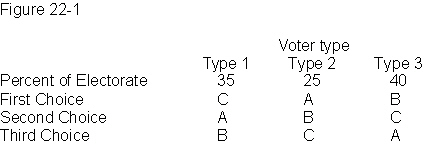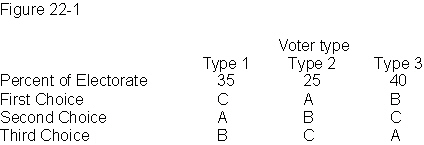True/False
Indicate whether the
sentence or statement is true or false.
|
|
|
1.
|
Asymmetric information is a problem that occurs
when one person in a transaction knows more about what is going on than the other.
|
|
|
2.
|
In the principal agent relationship, the principal
performs a task on behalf of the agent.
|
|
|
3.
|
Employers may pay higher than equilibrium wages to
avoid moral hazard in the employment relationship by raising the cost of shirking.
|
|
|
4.
|
To avoid the problem of adverse selection,
insurance companies screen their prospective customers to discover hidden health
problems.
|
|
|
5.
|
Signals to convey high quality are most effective
when they are costless to all firms in the industry.
|
|
|
6.
|
If A is preferred to B, B preferred to C, and A is
preferred to C, then these preferences exhibit the property of unanimity.
|
|
|
7.
|
The Condorcet paradox shows that majority-rule
voting always tells us the outcome that society really wants.
|
|
|
8.
|
Arrow's impossibility theorem shows that no
voting system can satisfy the properties required of a perfect voting system.
|
|
|
9.
|
According to the median voter theorem, majority
rule will produce the average preferred outcome.
|
|
|
10.
|
Politicians do not always choose the ideal economic
policy because some politicians are corrupt and greedy, and others are willing to sacrifice the
national interest for local popularity.
|
|
|
11.
|
In the real world, people always behave rationally
when making economic decisions.
|
|
|
12.
|
The ultimatum game demonstrates that people will
always make choices according to their self-interest.
|
|
|
13.
|
Since people tend to care about fairness, firms may
give bonuses during particularly profitable years to be fair and to avoid retaliation from the
workers.
|
|
|
14.
|
People seem to naturally engage in delayed
gratification and they tend to follow through on plans made today to do something unpleasant in the
future.
|
|
|
15.
|
Since people are reluctant to change their minds in
the face of new information, we can conclude that people do not always behave as rational
maximizers.
|
Multiple Choice
Identify the
letter of the choice that best completes the statement or answers the question.
|
|
|
16.
|
John's car is in need of repair so John
decides to sell it to avoid the repair bill. Unaware of the problem, Suzanne buys the car. This is an
example of
a. | hidden actions. | b. | adverse selection. | c. | efficiency
wages. | d. | moral hazard. |
|
|
|
17.
|
Nicole wants to avoid buying a car that is a lemon.
She takes a car she would like to buy to her mechanic before she purchases it. This is known
as
a. | screening. | b. | signalling. | c. | moral
hazard. | d. | adverse
selection. |
|
|
|
18.
|
Markus is a travelling salesman for an apparel
company. In this employment relationship, Markus is the
a. | agent. | b. | principle. | c. | screener. | d. | signaller. |
|
|
|
19.
|
Which of the following must be true about a signal
that is used to reveal private information in order for the signal to be effective?
a. | It must be "as seen on
TV." | b. | It must be free to the signalling
party. | c. | It must be costly to the signalling party but less
costly to the party with the higher-quality product. | d. | It must be applied to an inexpensive
product. |
|
|
|
20.
|
Which of the following is an example of a signal
that is used to reveal private information?
a. | Enzo carefully chooses a special gift for
Josephine. | b. | Josephine earns
her MBA from the Harvard Business School. | c. | Lexus advertises
its cars during the football World Cup Final. | d. | All of these
answers are correct. |
|
|
|
21.
|
Which of the following is not a method firms use to
avoid the moral hazard problem in the employment relationship?
a. | They pay employees with delayed compensation such as a
year-end bonus | b. | They buy life
insurance on their workers | c. | They pay above
equilibrium wages | d. | They put hidden
video cameras in the workplace |
|
|
|
22.
|
Which of the following best demonstrates the
problem of moral hazard?
a. | Josephine doesn't buy health insurance because it
is too expensive and she is healthy. | b. | A life insurance
company forces Enzo to have a medical examination prior to selling him
insurance. | c. | Enzo drives more
recklessly after he buys car insurance. | d. | Fatima chooses to
attend a well-respected college. |
|
|
|
23.
|
A life insurance company forces Enzo to have a
medical examination prior to selling him insurance.
a. | transitivity. | b. | impossibility. | c. | independence. | d. | unanimity. |
|
|
|
24.
|

Refer to Figure 22-1. What percent of the population votes for A when the
choice is between A and B?a. | 75 percent | b. | 35 percent | c. | 60
percent | d. | 40 percent | e. | 25 percent |
|
|
|
25.
|
 Refer to Figure 22-1. Under pairwise majority voting, which outcome
wins? Refer to Figure 22-1. Under pairwise majority voting, which outcome
wins?a. | C | b. | These preferences
suffer from the Condorcet paradox so there is no clear winner. | c. | B | d. | A |
|
|
|
26.
|
 Refer to Figure 22-1. If we first compare A to C, and then compare the winner
to B, which outcome is the winner? Refer to Figure 22-1. If we first compare A to C, and then compare the winner
to B, which outcome is the winner?a. | A | b. | C | c. | B | d. | These preferences
suffer from the Condorcet paradox so there is no clear winner. |
|
|
|
27.
|
 Refer to Figure 22-1. Using a Borda count, which outcome is
preferred? Refer to Figure 22-1. Using a Borda count, which outcome is
preferred?a. | C | b. | B | c. | A | d. | These preferences
do not exhibit transitivity so there is no clear winner. |
|
|
|
28.
|
Which of the following is not a property required
of a perfect voting system?
a. | the median voter always wins | b. | no dictators | c. | independence of
irrelevant alternatives | d. | transitivity |
|
|
|
29.
|
Suppose that 40 percent of the voting population
wish to spend €1,000 for artwork in City Hall, 25 percent wish to spend €20,000, and 35
percent wish to spend €22,000. What is the median preferred outcome, the average preferred
outcome, and the modal preferred outcome?
a. | €20,000; €20,000;
€22,000 | b. | €1,000;
€14,333; €1,000 | c. | €20,000;
€13,100; €1,000 | d. | €1,000;
€20,000; €22,000 |
|
|
|
30.
|
Which of the following is true under pairwise
majority rule if people vote for the outcome closest to their most preferred outcome?
a. | The average preferred outcome
wins. | b. | There is no clear winner due to Arrow's
Impossibility Theorem. | c. | The outcome
preferred by the median voter wins. | d. | The outcome
preferred by the greatest number of voters wins. |
|
|
|
31.
|
Which of the following is not true about how people
make decisions?
a. | People give too much weight to a small number of vivid
observations. | b. | People are
sometimes too sure of their own abilities. | c. | All of these
answers are actually true statements about how people make decisions. | d. | People are always rational maximizers. | e. | People are reluctant to change their minds in the face of new
information. |
|
|
|
32.
|
In the ultimatum game, what split would be rational
for both the person proposing the split and the person who must accept or reject the
split?
a. | There is no rational
solution. | b. | 75/25 | c. | 99/1 | d. | 1/99 | e. | 50/50 |
|
|
|
33.
|
Which of the following help explain why firms pay
bonuses to workers during particularly profitable years to prevent workers from becoming
disgruntled?
a. | People are rational
maximizers. | b. | People are
reluctant to change their minds. | c. | People are
inconsistent over time. | d. | People care about
fairness. |
|
|
|
34.
|
John's friend dies of a sudden heart attack.
John rushes to his doctor for an expensive physical examination. This response demonstrates
that
a. | people give too much weight to a small number of vivid
observations. | b. | people easily
change their minds when confronted with new information. | c. | people enjoy going to the doctor. | d. | people tend to plan ahead and follow through on their
plans. |
|
|
|
35.
|
Which of the following is a response to
people's inconsistent behaviour over time?
a. | all of these answers | b. | forced contributions to a retirement plan | c. | year end bonuses | d. | efficiency
wages |
|